


|
 |
|
|
#1 |
|
Registered Member
Join Date: Mar 2005
Location: Mexico
Posts: 1,866
|
The Guide to get rid of dinoflagellates
Hi, hopefully this guide will help you get rid of your dinoflagellates issues. I´ve been fighting dinoflagellates for more than 2 years and finally I got rid of them. It´s been that long because at the beggining I thought they were hair algae. They can´t be treated like normal algae.
The first thing you need is a positive ID. Let me show you some pictures of how they look like:   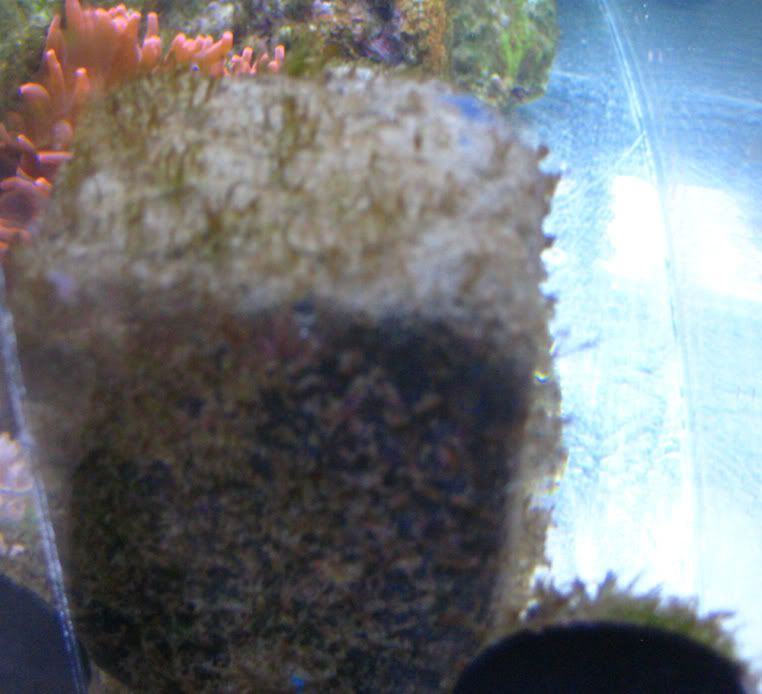 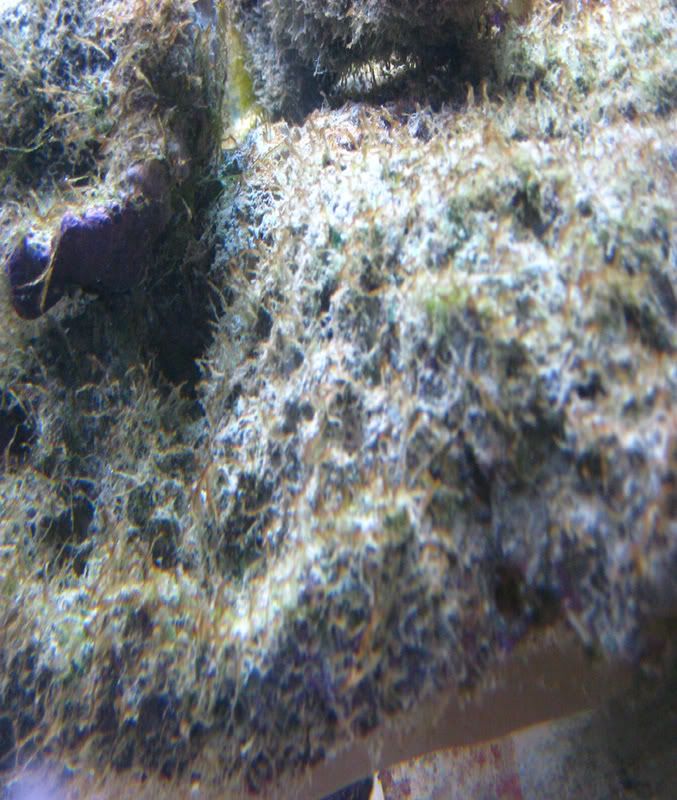 They basically look like brown hair algae but with lots of bubbles, plus they grow extremely quick and are very invasive, even if you scrap them off or use cleanup crew, they can cover a rock in a day. Here´s my tank before the problem:  Here´s when the problem began, it quickly covered the tank:  Why did it began?, the water quality was perfect and they probably came with a rock or coral. Perfect water quality can trigger their growth, this will be discussed later on. During 2 years I tried every method to get rid of the, weekly water changes, phos reactor, carbon, sump with macros. Nothing worked. The weirdest thing was that water quality always showed 0 nitrates and 0 phosphates, either from the RO unit or the tank, and I used different test to measure it. I was told the dinoflagellates were consuming every nutrient before it could be read, and so that´s why I kept with the water changes, etc. This proved to be false at the end. There´s an article at reefkeeping about how to get rid of dinos by increasing ph and using lots of rowa phos in your reactor: http://www.reefkeeping.com/issues/2006-11/rhf/index.php I raised my ph to 8.5-8.7 for several weeks as well as using the phos reactor, it did nothing to them. Why is that?, according to the article, there could be many species of dinoflagellates, some of them like the one in the article are toxic, you can start losing snails that eat them. Apparently this is the species that die with high ph, my species of dinos turned out to be non toxic and not affected by high ph. So what did I do?, I started adding lots of sea hares, 6 of them, they reduced the dino concentration but reached a poing where they could not reduce it any longer, the dino popullation was steady, the sea hares would clean a rock and next day the rock had new dinoflagellates growing on it.   As suggested by other RC members I removed the sandbed, this eliminated 50% of the problem, but the rest could not be reduced any more. So another RC member suggested a weird aproach: Increasing the nitrates!, and he told me to read this article which has a very scientific aproach: http://rds.yahoo.com/_ylt=A0oGkwx8se...382/382-57.pdf To make it short, the article explains that dinoflagellates posses bacteria inside of them, wheather beneficial or parasitic bacteria I don´t know and I don´t care, but the important thing is that that bacteria can help eliminate them. According to the article, when nitrate is present in low concentrations, the bacteria inside the dinos start to multiply to a point where it makes the dinoflagellate explode and so it kills it. Something totally different from what we are used to hear about water quality in the reef, anyways I had nothing to lose so I didn´t do water changes for 2 months. After 2 months the nitrate was 2 ppm and the dinoflagellates were starting to dissapear, incredible isn´t it?, everything was almost gone all by itself and the sea hares were helping get rid of it, this time the dinos were not comming back. There was to much sea hare excrement on the bottom, you must constantly syphon it through the filter sock, and then clean the filter sock in order to not do the water changes.   I thought the problem was over so I decided to do a water change. Inmediately the dinoflagellates came back the next day, a reading showed that nitrates were 0 again. Phosphates have always read 0 so they don´t seem to play a very important part, anyways its a good idea to keep them at 0, but do not keep nitrates at 0 while having dinoflagellates. With time nitrates started to be present again until dinos almost dissapeared. Try to keep nitrates within 2 to 3 ppm, this range is perfectly safe for fish and corals, levels higher than 3 ppm will feed other algae and corals will start losing coloration. So if nitrates reach more than 3 ppm do a small water change, small enough to reduce them to less than 3 ppm but no less than 2 ppm or else dinos will come back. Keep this levels for several months just to make sure they don´t come back. After that you can do a large water change to reduce nitrates to 0 and probably the dinos will be gone forever. I´m not the only one who has tried this aproach, some friends have also done the same and it has totally worked. If you want you can try the ph method before, if that doesn´t work then try the nitrate method and if it is not working, get rid of the sandbed while still treating with the nitrates method, you will start seeing the dinos dissapear when the nitrates start showing on the test. Sea hares help get rid of the problem quicker, but don´t forget to filter their excrement through the sock. Last edited by plancton; 04/15/2009 at 10:38 PM. |
|
|

|
|
|
#2 |
|
Registered Member
Join Date: Mar 2005
Location: Mexico
Posts: 1,866
|
And so the problem is gone:
   
__________________
Hansel, he´s so hot right now... |
|
|

|
|
|
#3 |
|
Registered Member
Join Date: May 2007
Location: California
Posts: 3,031
|
Thanks for sharing your experience. Do you think you'll be re-adding your sand bed now that you have found an apparent trick to getting rid of the dinos?
__________________
-Eric Sutter Current Tank Info: 14g Biocube |
|
|

|
|
|
#4 | |
|
Registered Member
Join Date: Sep 2008
Location: Wake Forest, NC
Posts: 3,696
|
Re: The Guide to get rid of dinoflagellates
Quote:
That certainly is unusual. If that's the case, as it seems to be for your situation, that is very good news. I have a lower-level dino outbreak in my 20g frag tank right now, but it's only a month old so this is normal. However, the nitrates in the tank went as high as 20ppm, at which point I added a refugium and now they are down to around 3-4. When the nitrates were the highest, so was the dino population. I suspect that if bacterial action can kill off dinos, that not all dinos will be affected by it. That being said, I also think there is something to be said for your steadfast endurance. I would wager that your persistence and patience killed the dinos as much as anything! What was your nitrate source?
__________________
"The measure of a life is not its duration but its donation." Corrie Ten Boom The tyrant dies and his rule is over, the martyr dies and his rule begins -- Søren Kierkegaard Current Tank Info: ghetto grad school reef.....11g rimless tank, 36X9X9, lit by Cree and Rebels scobbled together. Stocked mostly with free stuff I got from panhandling my fellow reefers. |
|
|
|

|
|
|
#5 |
|
Registered Member
Join Date: Jun 2008
Posts: 331
|
This is really helpful -- I have a 55 where I am skimming and skimming and it still looks like crap, and I think it's b/c of dinoflagellates.
|
|
|

|
|
|
#6 | |
|
Registered Member
Join Date: Mar 2005
Location: Mexico
Posts: 1,866
|
Re: Re: The Guide to get rid of dinoflagellates
The essay suggest that dinos die at low nitrate concentrations, I don´t know what would happen with high concentrations such as 20 ppm, my guess is that it would create enough nutrientes for bacteria and dino blooms alike.
In my experience the best is to keep them at a 2-3 ppm nitrate range, 3-4 might start causing other problems. My nitrate source is the tank itself, somebody suggested adding nitrate products, but there are many elements that contain nitrogen and we don´t know which ones work etc. So the best is to just stick to the tank producing its own nitrogen. It was extremely visible how going back to 0 nitrates would inmediately trigger another bloom. That´s why people can´t get rid of them, cuz they keep doing water changes looking for the perfect water quality thinking that would get rid of them. I don´t know if I would go back to the sandbed, It was a pain to remove it, so much work to do in case I have to remove it again, and even though I stirred it all the time before removing it, once you remove it you realize its full of dirtness. Also mantainance is ridiculously easy without sandbed, also you have to be more careful with the sandbed in order to not scratch the acrylic. I would go starboard, which looks like sand, although I´m guessing hte starboard would get covered with coraline algae, that´s what I have to find out. Quote:
|
|
|
|

|
|
|
#7 |
|
Registered Member
Join Date: Sep 2008
Location: Wake Forest, NC
Posts: 3,696
|
One of the biggest problems with dinos is, just like Plancton said, they will remove all your phosphate and nitrate, making it look like you have "perfect" water quality.
The problem is that there is still a nutrient source. If there were no nitrogen or phosphorus coming from somewhere, the dinos would die off most likely. They just suck it out before anything else can. It's a shame we can't figure out how to make a dino refugium where they continuously bloom but cannot make it into the main tank. A great way to ensure a ULNS situation! By skimming, you are competing with the lil brats, to some degree, for nutrients--- a very good thing. The skimmer also helps to drive off CO2 in the water, helping keep the pH high. I am starting to wonder if there is something "seasonal" about dinoflagellates. Seems like all of a sudden there are piles of posts here and elsewhere about dinoflagellate blooms.
__________________
"The measure of a life is not its duration but its donation." Corrie Ten Boom The tyrant dies and his rule is over, the martyr dies and his rule begins -- Søren Kierkegaard Current Tank Info: ghetto grad school reef.....11g rimless tank, 36X9X9, lit by Cree and Rebels scobbled together. Stocked mostly with free stuff I got from panhandling my fellow reefers. |
|
|

|
|
|
#8 | |
|
Registered Member
Join Date: Mar 2005
Location: Mexico
Posts: 1,866
|
Take a picture of the problem and post it here, I´ll tell you what it is.
Also test for nitrates and phosphates and tell us the reading. Skimming is ok, I always skimmed while I was having the dino problem, the truth is, I don´t know what would happen if you stop skimming, perhaps the nitrates would appear fast and eliminate the dinos, or perhaps another problem would be created since there are many thigns that play a role in the tank chemistry: inorganic compaunds as well as organic ones. Quote:
|
|
|
|

|
|
|
#9 | |
|
Registered Member
Join Date: Mar 2005
Location: Mexico
Posts: 1,866
|
You might be getting it wrong, this is exactly why it took me so long to get rid of them. People kept telling me that the dinos were sucking nutrients so fast, while in reality they weren´t.
Think about it, I only had 5 small fish in a 175 gal, before the problem started nitrates and phosphates were always 0, and also during the problem, cuz I have a good skimmer, to a some point I did weekly water changes, etc. The water quality was always good, there was nothing they could feed on, basically they feed on light and trace elements in the salt, they are photosinthetic but they ain´t algae. The momment I stopped doing water changes and bought a nitrate test kit is the momment when they started to die when the nitrates started to appear because of the lack of water changes. Quote:
|
|
|
|

|
|
|
#10 |
|
vegasreefers.com
Join Date: Feb 2006
Location: Las Vegas
Posts: 742
|
Very Interesting.
|
|
|

|
|
|
#11 |
|
Registered Member
Join Date: Apr 2007
Location: Uranus
Posts: 3,094
|
oye plancton, lei tu otro post sobre el tema y habias dicho que quitando la arena ayudaria mucho, que bueno que hay alguien que se preocupa por informarnos algo como hacerle para matar esa plaga, yo los combati por 2 semanas y gane, lo unico que creo que hice es succionarlos y sacarlos del tanque principal, ademas yo no cambio el agua y siempre he tenido ~.2 a 2 ppm de nitrato, oye perteneces a allreefs tambien?
Sana
__________________
Senior Member of the "Hardly any Water Changes, Temp Swinging, T5ing, No Qtining, Frag Exchanging for Fish Food Current Tank Info: 90RR inwall, Octopuss Skimmer, 2 MP40 wQD, 1 MP10 WQD, 2 Radions G4 Pro, Apex Doser, Apex Controller, 400w heater, 30 Gal Sump, Biopellets, Carbon, Gfo, Macroalgae |
|
|

|
|
|
#12 |
|
Registered Member
Join Date: Mar 2005
Location: Mexico
Posts: 1,866
|
Si proximamente el post estará en all reefs, ahorita lo pongo.
__________________
Hansel, he´s so hot right now... |
|
|

|
|
|
#13 |
|
Registered Member
Join Date: Apr 2006
Posts: 686
|
I'm surprised no one else pointed this out but did you ever think it could be due to not doing a water change? A water change does a lot more than reduce nitrates, in fact if your going from a 3 to 0 ppm nitrate reading after a water change your apparently doing a 100% water change............this is the only way your nitrates could go from 2-3 to 0 with a water change. Have you read how much "stuff" is in your salt mix? All of those "elements" or "minerals" were more than likely feeding your dianoflagellates, not your lack of nitrates. I think what caused the dianoflagellates to die was they ran out of what they were feeding on, which was the "minerals" in your salt.
|
|
|

|
|
|
#14 | ||
|
Registered Member
Join Date: Sep 2008
Location: Wake Forest, NC
Posts: 3,696
|
Quote:
Plancton did mention this a post or three above: Quote:
I am skeptical that "minerals" of any sort from the salt mix were "feeding" the dinos, although they probably do require some trace minerals. All living organisms (if I understand correctly) require nitrogen and phosphorus. Neither of which are supposed to be in our salt mixes in any useable amount (although it happens by accident). The dinos were most certainly getting nitrogen and phosphorus from somewhere--- without them they would have died. But as Plancton rightly noted, dinos aren't a simple algae. Perhaps they can assimilate nitrogen and phosphorus at a higher trophic level than algae (ie, they can "feed" directly off of larger components like detritus). It's quite possible that the dinos did deplete some necessary trace element from the water. Sprung, in his book on algae, suggests ending all water changes until the dinos are gone. My guess is that when Plancton started dosing nitrate, it actually (for a brief amount of time) "superchaged" the dino metabolism so much that it quickly petered out some trace element that it required. Lol, if you do a water change any time soon, you might want to leave the lights off for a few days just in case they "wake up"!
__________________
"The measure of a life is not its duration but its donation." Corrie Ten Boom The tyrant dies and his rule is over, the martyr dies and his rule begins -- Søren Kierkegaard Current Tank Info: ghetto grad school reef.....11g rimless tank, 36X9X9, lit by Cree and Rebels scobbled together. Stocked mostly with free stuff I got from panhandling my fellow reefers. |
||
|
|

|
|
|
#15 |
|
Registered Member
Join Date: Mar 2005
Location: Mexico
Posts: 1,866
|
Like redfishsc pointed out, it could be possible that dinos were feeding on larger components such as detrius, that would explain why the removal of the sandbed helped a lot.
I don´t know if they are feeding on trace element on the salt but there is a direct relation of them dying when small nitrate concentrations. For example last time they started to die when nitrates were 2 ppm, they have been thriving this month in low quantities and my reading showed 0 nitrates last week, however this week I´ve seen them starting to die again, I suspect the nitrates are rising again. After a water change nitrates do drop to 0, and this is very possible since for example 2.5 ppm is a very low nitrate reading, besides the reading might not be necessarely 0, but just below 2ppm which is the minimium measure in most test kits. I didn´t know Sprung also mentioned not doing water changes. Oh and there´s another evidence that the sudden slow decline this week on the dino population might have to do with nitrates rising: Monti caps are coloring up again, long time ago, basically since I set up my tank, I noticed that monti caps broght from other tanks were losing their colors in my tank, where the nitrates were 0. My LFS said he came to the conclusion long time ago that monti caps need low nutrient levels 2-3 ppm to have good coloration, this phenomenon might be related only to monti caps, and these low nutrients don´t seem to be affecting the other corals´coloration. So a month ago before the last water change, nitrates were 2.5 ppm and the monti caps were fully colored, the week after the water change they became very pale and now they are starting to gain color again after a month at the same time that dinos are starting to decline. I will be creating another topic related to this coloration on low nutrient levels with a picture of the monti cap at 0 ppm nitrate compared to 2-3 ppm nitrate. BTW. I don´t recommend directly dosing nitrate, don´t know what could happen, just let the tank get dirty on its own.
__________________
Hansel, he´s so hot right now... Last edited by plancton; 04/16/2009 at 06:50 PM. |
|
|

|
|
|
#16 |
|
Registered Member
Join Date: Sep 2008
Location: Wake Forest, NC
Posts: 3,696
|
You can safely dose nitrate so long as you are meticulous about the way you meter it out.
I made my own homebrew of nitrate by cycling standard household ammonia (ammonium hydroxide from the cleaning aisle at Walmart) in a bucket with a sponge filter from an established tank. You can also use potassium nitrate (saltpeter, from a pharmacy) or calcium nitrate from a lab supply (don't use agricultural grade, it has traces of phosphate). I would only dose enough to raise the tank by 0.3ppm per day to start. Higher levels only with close observation and patience.
__________________
"The measure of a life is not its duration but its donation." Corrie Ten Boom The tyrant dies and his rule is over, the martyr dies and his rule begins -- Søren Kierkegaard Current Tank Info: ghetto grad school reef.....11g rimless tank, 36X9X9, lit by Cree and Rebels scobbled together. Stocked mostly with free stuff I got from panhandling my fellow reefers. |
|
|

|
|
|
#17 |
|
Registered Member
Join Date: Mar 2005
Location: Mexico
Posts: 1,866
|
Horrible thing just happened, After 2 months since last water change dinos were almost gone, but today the main pump´s hose got loose and started to push water out of the tank. I lost about 15 gal (That´s the amount I normally change when I do water changes!!!).
Its very likely that tomorrow my tank is going to have another 2 month lasting dino bloom. I can either wait or try adding nitrogen. I have potassium nitrate (seachem´s fluorish nitrogen) should I add it?, my god why does this always happen to me?!
__________________
Hansel, he´s so hot right now... |
|
|

|
|
|
#18 |
|
Registered Member
Join Date: Feb 2004
Location: Milwaukee
Posts: 6,081
|
It's suggested by many people, including myself, that people cease doing water changes during dinoflagellate outbreaks. I have some serious doubts about your reasoning behind not doing tyhe water changes though. When I look at the photos of your tank after the outbreak I see a tank with a melange of algae problems and something simply not possible if a tank has "perfect water quality". I really hope you're onto something but I feel as if you're making some big leaps to draw some of the conclusions you have.
I'm curious, how long has this tank been set up in the various photos and what are the details? In particular what type of filtration are you using?
__________________
April 2015 TOTM |
|
|

|
|
|
#19 |
|
Registered Member
Join Date: Sep 2008
Location: Wake Forest, NC
Posts: 3,696
|
Well, my opinion on beating dinoflagellates is that martial law is the rule of the day.
Pretty much whatever it takes, so long as it doesn't break (many) of the 10 Commandments....
__________________
"The measure of a life is not its duration but its donation." Corrie Ten Boom The tyrant dies and his rule is over, the martyr dies and his rule begins -- Søren Kierkegaard Current Tank Info: ghetto grad school reef.....11g rimless tank, 36X9X9, lit by Cree and Rebels scobbled together. Stocked mostly with free stuff I got from panhandling my fellow reefers. |
|
|

|
|
|
#20 | |
|
Registered Member
Join Date: Mar 2005
Location: Mexico
Posts: 1,866
|
Since I accidentaly lost 15 gal, I had was obligated to replace them. After removing the sandbed there was no other type of algae left but the dinoflagellates, it seems that they start as a film type and when they overun a rock they form strong root like shapes on it, that´s why it looks like there are other types of algae present but its part of the same deal I´ve figured and it also goes away when nitrates start to be detectable, in these last days they were almost gone that´s why I started adding nori to my tangs yesterday and I was worried about the future of my sea hares and suddenly this.
I took a nitrate test last week and it showed less thatn 1ppm nitrate, not even 1 ppm yet. Don´t have new pictures but I can tell you it was looking crisp clean, untiil probably now. I haven´t even checked the tank yet. Quote:
|
|
|
|

|
|
|
#21 |
|
Registered Member
Join Date: Aug 2006
Location: Pace
Posts: 437
|
Great thread. I am going through a dino outbreak myself. Unforunately, I just did a 20% water change.
|
|
|

|
|
|
#22 |
|
Registered Member
Join Date: Aug 2006
Location: Pace
Posts: 437
|
 
|
|
|

|
|
|
#23 |
|
Registered Member.
Join Date: Aug 2006
Location: NYC
Posts: 2,009
|
Is this the same ?
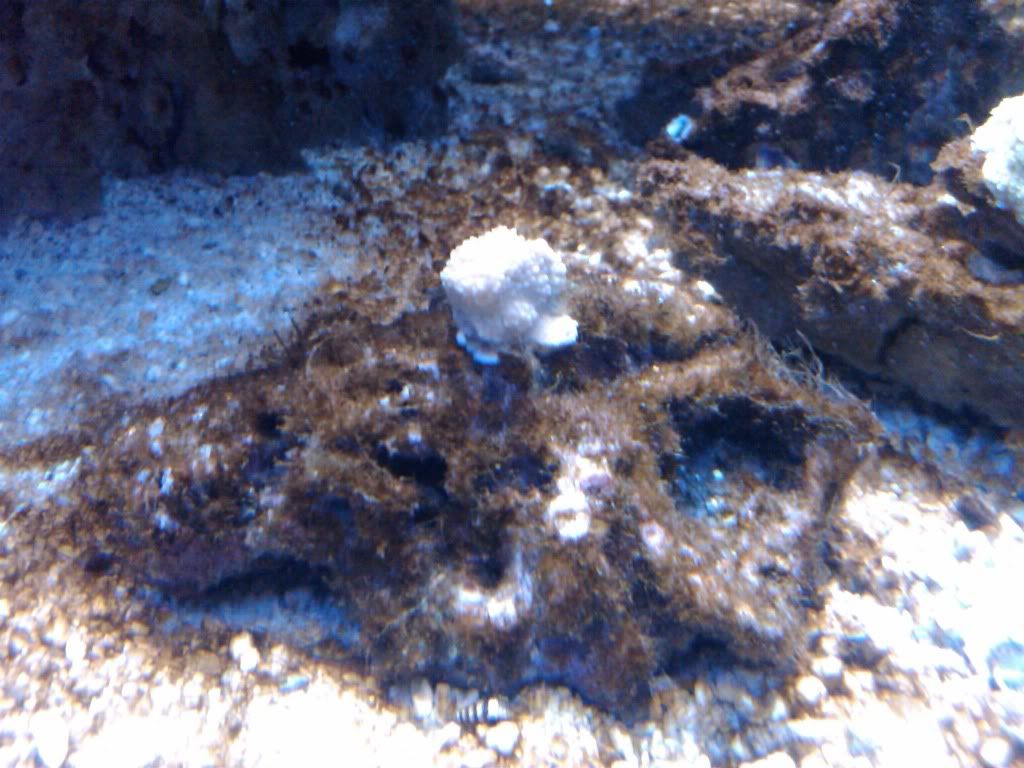 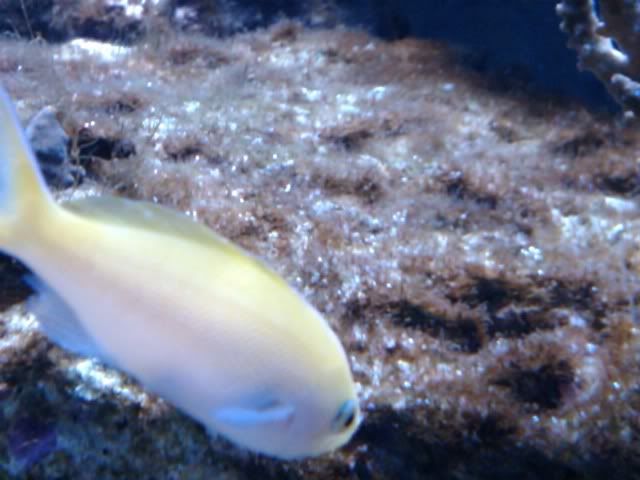 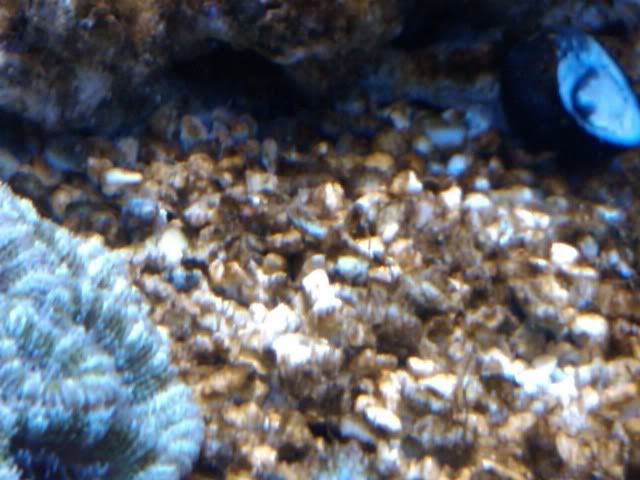
|
|
|

|
|
|
#24 |
|
Registered Member
Join Date: Sep 2008
Location: Wake Forest, NC
Posts: 3,696
|
It could be. The biggest tell-tale signs are bubbles, a slimy consistency, and occasionally if you have a bright white object in your tank (PVC or eggcrate) you can actually see an individual animal moving around if you look close enough. Dino's are pretty big for a "microscopic" animal. It's hard, but possible, to see them moving around.
__________________
"The measure of a life is not its duration but its donation." Corrie Ten Boom The tyrant dies and his rule is over, the martyr dies and his rule begins -- Søren Kierkegaard Current Tank Info: ghetto grad school reef.....11g rimless tank, 36X9X9, lit by Cree and Rebels scobbled together. Stocked mostly with free stuff I got from panhandling my fellow reefers. |
|
|

|
|
|
#25 |
|
Registered Member
Join Date: Aug 2009
Posts: 273
|
Whats the best way and fastest way to get my nitrates up, feeding is the only thing I can think of.
|
|
|

|
 |
|
|